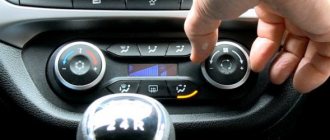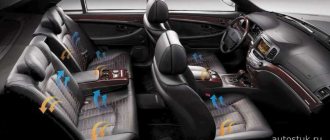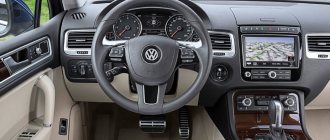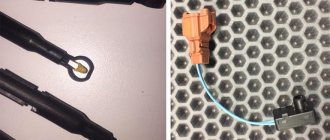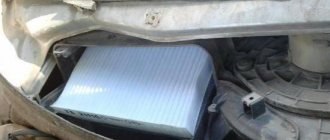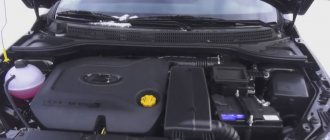- Auto
- Additional options
- How to install climate control instead of air conditioning on Lada vesta
- Air conditioners
- Lada Vesta air conditioning does not work??? experiment kondeya lada vesta
- Lada Vesta has acquired a package of winter options
- Lada Vesta installation of climate control instead of air conditioning
- Disadvantages identified during operation
- The current configuration is heat-cold in manual mode
- Review of the Lada Vesta St operating manual
- Benefits of installing climate control
- Differences in Lada Vesta settings
- Lada Vesta instruction manual
- Installation
- Sauku device
- Climate control functions
- What are the different modifications equipped with?
- What are the owners' reviews today about the exterior of the new flagship Lada Vesta: are their hopes justified?
- Behind the wheel: reviews of the driving performance of the Lada Vesta and videos of real tests
Auto
When you press the AUTO key, the control unit independently not only supplies the desired air temperature to the Lada’s interior, but also controls:
- Air flow speed with the value displayed on the display;
- Distributes air flows through certain deflectors;
- Controls the temperature of the supplied air;
- Depending on the environment, it switches on recirculation and air conditioning modes.
You should know that you cannot use a closed air intake damper for a long time, as in this case the windows will fog up and an unpleasant odor will appear in the cabin, and the driver may experience oxygen starvation, which will lead to an emergency.
Important Notes
- The air conditioner will turn on only when the engine is running, the interior fan is turned on at any speed and when the outside air temperature is not lower than minus 5 ° C
- When the air conditioner is running, drops of water may appear under the bottom of the car - this removes condensed moisture from the air.
- When the button is pressed, at least one of the central or side nozzles must be open, otherwise the air conditioner evaporator may freeze and cut off the air supply to the cabin.
- It is recommended to direct the air from the ventilation nozzles slightly upward. Do not block the windshield and side window blower nozzles on the instrument panel, as well as the footwell blower nozzles of the front and rear rows of seats with various objects.
- When the car is moving, the heater/air conditioning fan should always be turned on, at least at 2nd speed, to create excess pressure in the cabin in order to prevent dust and dirt from entering through leaks in the body, as well as to avoid fogging up the windows.
- When washing a car, do not turn on the climate system fan.
- When using the air conditioner in conditions of high air humidity and outside temperature from minus 3 ° C to plus 5 ° C, it is recommended to turn on the air conditioner fan at least at speed 3 to avoid freezing of the cooler.
- Do not direct cooled air onto the windshield when the outside air humidity is high! This may cause the glass to fog up or freeze and impair your vision.
- It is not recommended to direct the flow of cooled air onto the face and open areas of the body - this can lead to hypothermia and illness.
- When the air conditioner is operating, the specific fuel consumption increases, because Additional power from the engine is required to drive the compressor.
- Driving in mountainous areas or in difficult road conditions with a trailer may cause the air conditioning compressor to be switched off to prevent engine overheating. In this case, the air entering the cabin will not be cooled. To turn off the air conditioner, press the “air conditioner” button again, the indicator light will go out.
Additional options
In addition to the standard set of keys, the Lux version also has some other features. There is a key for switching operating modes for heating the feet, as well as intermediate ones - “ventilation - to the feet”, as well as “to the glass - to the feet”. Vesta also has a switch for blowing the windshield and side windows, as well as an intermediate mode - “on the glass - at the feet”.
Climate control in the top version of the Lada Vesta has a number of additional options that are activated by the corresponding keys.
The model also boasts the ability to intensively heat the windshield by turning on the max defrost function, the button of which is also backlit. If this mode is selected, the orange indicator lights up, and the entire air flow is directed exclusively to the glass.
The ergonomics of Vesta are well thought out. The climate control control unit is not covered by the gearbox selector.
If passengers select a specific operating mode - ventilation, heated feet or glass - the indicator on the corresponding key lights up. Whereas the activation of the intermediate mode is due to the illumination of 2 keys, which depends on the combination. A small information board on the left displays information regarding the specified temperature, and on the right - on the intensity of the airflow.
It is difficult to imagine a modern car without comfortable conditions for the driver and passengers. Almost all foreign cars are equipped with an air conditioner or climate control system operating in automatic mode. AvtoVAZ has started production of a new luxury version of the Lada Vesta with climate control.
Lada Vesta
Before this, cars were equipped with a heating and cooling system. It consists of a heating furnace, used in cold times, and an air conditioner, used in warm times. The system is controlled manually.
When equipping a car with a modern climate control system, there is no need to manually set parameters. Vesta of the “luxury” version automatically maintains the specified range, monitoring and adjusting several parameters at once. A modern electronics unit constantly monitors the temperature:
- Ambient air;
- Coolant;
- Inside the Vesta car.
The climate control system, using a control unit, compares indicators and selects the optimal way to operate the air conditioner, stove and ventilation device. The temperature inside the Lada Vesta is maintained constant.
Unlike the “comfort” and “classic” trim levels, where an air conditioner is installed on the Lada Vesta, and the climate control unit is adjusted manually, the “luxury” car has an AUTO button. When pressed, the electronic climate control unit is turned on.
How to find out about temperature
The Lada Vesta interior temperature indicators are displayed on an indicator installed between the control knobs. The driver is guided by the image on the graphic scale and the fan rotation speed, since there are no digital values in the heater control unit.
The designers of this Vesta model equipped the climate control with several versions of air supply. How does climate control work? There are five combinations: simple - exclusively blowing the legs, and combined - parallel blowing the driver's legs and face.
Switching is carried out using buttons located at the bottom and top of the indicator, three in each. The middle button from the bottom row is used for synchronized blowing of the windshield, heating of the side mirrors and rear window. When the option is activated, the LED backlight turns on.
How to install climate control instead of air conditioning on Lada vesta
Currently, the climate control option is only available in the Luxe and Exclusive trim levels. Simpler versions of Lada Vesta (Comfort and Classic Start) are equipped with air conditioning. Did you know that you can replace your air conditioner with climate control yourself? Let's figure out how to do this and what is needed for this.
The main differences between the “air conditioning” and “climate control” options:
- On a car with climate control, the air conditioning is turned on via the CAN bus (with the “air conditioning” option - through a separate wire going to the ECU);
- On a car with climate control, the heated windows and mirrors are activated via the CAN bus;
- On a car with climate control, there are two additional temperature sensors: interior temperature and evaporator temperature;
- On a climate-controlled vehicle, the temperature and servo dampers are controlled by a separate controller.
Attention! After installing the climate control, you will need to “register” it in the CBKE or modify the climate control unit (solder a piece of wire, see photo below), otherwise the glass heating will not work. This happens due to different types of signals. A simple air conditioner uses analog control, while climate control uses digital control via a CAN bus.
Required:
- Interior temperature sensor (article 277200005R);
- Air temperature sensor (evaporator), Valeo N100468L (277230128R);
- Climate control panel (8450007074);
- Automatic climate control controller (8450008027). Its firmware (adaptation) will be required. In this case, the controller was purchased as a disassembled unit, so no adaptation was required;
- Connectors, 2 pcs. 40 pins each (AMP 1379671), 1 pc. for 12 pins (1898005460AS), from TE Connectivity and the pins themselves (or buy a ready-made wiring harness).
Air conditioners
Air Conditioning Compressors and Piping
Air conditioner for VAZ 2110-2170, Bogdan August V16
Power steering diversion kit for installing air conditioner August for Lada Priora, VAZ 2110-2112
Electronic thermostat Bogdan 09-000201-00 12V
Evaporator with housing assembly for VAZ 2110-2170 Bogdan August
Thermostatic valve TRV for Bogdan
Air conditioner radiator fan August VAZ 2110-2170, Bogdan
Condenser with receiver assembly August VAZ 2110-2170 Bogdan
Power steering tensioner bracket Bogdan
Generator bracket Bogdan
Pillow bracket Bogdan
Air conditioning pipeline for VAZ 2110-2170 Bogdan 05-100100-00
Liquid air conditioner pipeline for VAZ 2110-2170 Bogdan 05-100200-00
Air conditioner suction pipeline for VAZ 2110-2170 Bogdan 05-100300-00
Set of brackets for power steering pump and tension pulley for Lada Priora, VAZ 2110
The VAZ air conditioner consists of a receiver and an evaporator. The set of air conditioners for VAZ cars includes all the necessary pipes and fastening mechanisms. For almost every air conditioner you can buy all the parts separately from us.
Theoretically, you can repair a broken air conditioner yourself. However, after repairs it is necessary to charge the air conditioner with freon. It is impossible to do this at home, without special equipment. Therefore, we recommend buying a VAZ air conditioner, or its components, in our store.
To avoid damage during delivery, delivery of air conditioners is carried out only by transport companies. We do not send air conditioners by Russian Post.
After installing an air conditioner on your VAZ car, it is also necessary to maintain it on time. With timely purging of radiators and replacement of filters, the service life of the air conditioner is significantly increased.
Didn't find the product you were looking for.
Good afternoon I ordered a set of side mirrors (painted) with heating, electric drive and a moving turn signal for Lada Kalina 1. Delivery by SDEK in 3 days (smooth work)! They even included fasteners, the quality is good. When it gets a little warmer, I'll install it. Thank you very much! I ordered for the first time, I will continue to make purchases here.
Alexey 02/17/2020 07:27
The cabin filter adapter has arrived. The parcel took 10 days to the Perm region. I'm happy with the order, everything came together. Thank you!
Sergey 02/11/2020 16:02
Lada Vesta air conditioning does not work??? experiment kondeya lada vesta
Heroin629:
something is cooling badly
MONO TYPE:
I don’t know... we were driving with the chick and we were fucking frozen... we had to warm it up))))
Ivan Ivanov:
It's the passengers who need to be cooled, not the windshield.
Dmitry Bel:
blowing in your head to the fullest. Piece of a moron. You don't know how to use a car. And throw away your exhaust. Head fucker. Sell the news and don’t torture yourself and people with your stupid videos.
Standard heater radiator
The antifreeze circulation circle between the heater radiator and the cooling system radiator is common, as a result of which dirt and debris penetrate into the heater. The quality of heating decreases. You can restore high-quality airflow by flushing the heating system.
The heater radiator is the same in design as the radiator of the Lada cooling system, only smaller. They have a common antifreeze range. Dirt from the expansion tank may also end up in the small interior assembly. Unfortunately, the radiator cannot be repaired. Need a replacement. When we come closer to the question, it turns out that the standard unit does not have a serial number. There is only a code - UT-00006936, according to which they can sell you another spare part. Therefore, before purchasing, check with the seller for information.
Lada Vesta has acquired a package of winter options
Igor Vladimirsky
Vesta’s range of trim levels now includes a new Comfort Winter position, that is, the most popular Comfort version (52% of sales) with an additional “winter package”. It does not involve fundamentally new options, but includes a set of equipment that was previously installed only on cars in the more expensive Luxe and Exclusive versions.
The Winter package includes electric heating of the windshield and steering wheel (the steering wheel itself is leather-wrapped), three-stage heated front seats (in the Comfort package it is single-stage), fog lights and 16-inch alloy wheels instead of “stampings”.
The surcharge for this kit for the “regular” sedan and station wagon is 36 thousand rubles, and for the Cross versions it is 21 thousand, because they have light-alloy wheels by default. A sedan with the Winter package costs at least 734 thousand rubles, for a station wagon they ask from 771 thousand, and Cross versions are estimated at 798 and 835 thousand rubles, respectively.
In addition, sedans in the Comfort Multimedia configuration with a touch screen instead of a conventional audio system now also have a leather-wrapped and heated steering wheel, although they are not entitled to other “winter” options. For such a Vesta they ask for a minimum of 742 thousand rubles, but this equipment is not offered for station wagons and Cross versions.
Source
Lada Vesta installation of climate control instead of air conditioning
Vestas with climate control appeared. Is it possible to replace the control unit for a “manual” air conditioner with a unit for automatic climate control? Is the difference only in the control units or is it more significant?
I am posting a diagram of the Vesta air conditioner
| Where is the temperature sensor located? |
As the owner of a Vesta with climate control, I will tell you my assumptions. The temperature sensor is most likely located in the mirror. or rather in a gray skin where the rain sensor is. There is a hole at the bottom and something is sticking out there. Some other sensors are visible at the very bottom of the windshield below the glass wipers, there are some silk-screened windows there and something can be seen in them.
But these are just my assumptions.
By the way, the LED for turning on the air conditioner in a configuration with climate control does not mean that the air conditioner is currently working. It turns on only when it is necessary to cool the air, and if it is already cool outside, the air conditioner does not turn on, but the button still lights up, which is somewhat confusing. For some reason I thought it should go out. AUTO is on anyway.
Source
Search and fix
1.Check the pressure in the system, if it is below the permissible level of 2 bar, the air conditioner may work, however, the air will be warm or not cool enough. 2. It also happens that the ambient temperature is less than +3 degrees Celsius, because when the minimum temperature threshold is reached, the air conditioner stops cooling. 3. Check the clutch fuse in slot F24 and relay K12. Carry out a visual inspection; the fuse must be intact and its seat must not have signs of oxidation or other abnormalities. Try wiggling the relay and if that is the problem, the air conditioner may start working. But keep in mind that if this was the reason, then it is worth carrying out repairs, otherwise the working relay may fail at the most inopportune moment. 4. The clutch may have burned out, and the air conditioner refuses to work because of this. If the compressor itself jams, specific clicks will be heard and the clutch will rotate freely. 5. If the air conditioning works but does not produce warm or hot air, then the cause may be a low freon level. This happens when there is leakage through loose connections. In this case, a special liquid is poured into the system, which glows when exposed to UV rays. The leak is detected and corrected, and then the system is refilled with freon.
If troubleshooting the air conditioner does not produce results, I advise you to contact specialists; if they have the necessary special equipment, they can easily find the cause and quickly eliminate it.
We wash Kalina's air conditioner video
Disadvantages identified during operation
Despite the fact that the car with an air conditioning system entered the market quite recently, some comments have already appeared in the work. Having systematized reviews of the Lada Vesta with climate control, we can highlight the following main disadvantages:
- The central vents have a limited range of adjustment;
- Turning on the air conditioner is accompanied by an incomprehensible crunching and rustling sound;
- The system is not very efficient in summer; it supplies cool air, but it is desirable to have cold air;
- The installation step should be 0.5 0 C, but now there is a step of 10 0 C, which is not enough to ensure comfortable conditions;
- The dampers crunch when switching them;
- The feet are blown not into the shoe area, but slightly higher, which is bad in severe frosts;
- It is inconvenient to turn on the heated windshield, rear windows and side mirrors with one switch.
- When turned on in severe frosts, uneven heating occurs; the rear one warms up much earlier than the front one. This defect can be eliminated by reprogramming the on-board computer. In Lada Vesta, when the MAX function is turned on, increased airflow is installed not only on the windshield, but also on the air conditioner. The default is the maximum temperature of the latter.
Lada Vesta is a representative of passenger cars produced by AvtoVAZ OJSC, and its comfort is determined by the ability to maintain optimal temperature conditions in the cabin. The climate control on the Lada Vesta is also responsible for heating the windshield.
What shortcomings have been identified?
Although the Lada Vesta car with climate control went on sale not so long ago, drivers and craftsmen have identified several shortcomings. You need to familiarize yourself with them in advance so that there are no problems during use.
- The flaps that move when the system is running are a bit crunchy. Therefore, inexperienced drivers may be wary. Their condition is periodically checked in order to prevent deterioration of the climate system and its rapid failure.
- The heated warm air mass is directed slightly higher than the pedals. It is not profitable to install air ducts this way, since the frosts in our country are quite severe.
- The blowing and heating of the rear windshields is uneven. Therefore, the ice crust from the rear window comes off faster. Therefore, acceptable visibility is not ensured. It is problematic to make appropriate changes to the settings of a unit such as air conditioning or climate control. Only responsible professionals can handle this.
- The central deflectors included in the composition have a small range for adjustment. This introduces certain restrictions.
In order to successfully use the climate control installed in the Lada Vesta car, you need to study the purpose of the control unit and buttons. After all, how effective the device will be depends on the correct use of the buttons. Therefore, in some cases, the help of a master or specialist may be required.
The current configuration is heat-cold in manual mode
On models currently being produced, even in the “sophisticated” modification of the Lada Vesta, the driver must manually switch the heating or cooling modes. This is manual climate control. To maintain the desired temperature, a complex consisting of a “stove”, an air conditioner and a fan is used. The mode control panel is located on the center console just above the gearshift lever.
The panel interface on currently produced Vesta cars is clear and easy to master in a few steps. The left handle (vernier) regulates the temperature of the air supplied to the cabin. Switching from heater to air conditioner is done by simply pressing this vernier.
What the control panel will look like in the future
When climate control is installed on the Lada Vesta, the general appearance of the control panel will remain the same. However, the content will change. So there will no longer be icons on the left vernier, but divisions will appear, which you need to navigate by. With their help, the driver will be able to visually control the level of warm or cold air supply.
But this is for manual control mode. In Lada Vesta it will be possible to switch to automatic, and then the climate system will independently set the temperature in the cabin, based on the sensor. To switch to automatic mode, just press the desired key in the bottom row.
You can switch from the air conditioner to the stove and vice versa by pressing the vernier. Air recirculation is started in the same way, only with the right handle. The temperature display in the Lada Vesta is displayed on a small digital display installed in the place where the graphic temperature scale is located in cheaper models. As in the simpler version, all buttons and knobs are equipped with indicator lights that light up after the mode is activated.
Review of the Lada Vesta St operating manual
The manual begins with getting to know the car. The first part of the book is called that. It describes in as much detail as possible about all kinds of functions, adjustments, instrument panel indicators, key assignments, etc.
The buyer is first offered an overview of the car, such as information about the car's keys, control of the original alarm system, location of the pedal assembly, and turning the warning lights on and off.
This chapter describes in great detail about car seats - how to adjust them, how to properly use seat belts and install a child seat.
Benefits of installing climate control
What benefits did car owners receive after installing a climate system?
- The set temperature regime is maintained automatically. If necessary, the control unit adjusts the set mode. Manual adjustment is not necessary.
- The system includes an efficient electronic unit. It makes it easy to set temperature changes. Therefore, cooling and heating are carried out quickly.
- Car drivers concentrate on the road and maneuver. The temperature or air supply is not adjusted. All these actions are performed automatically. If necessary, reprogram the control unit.
- Functions such as heating and cooling are turned off automatically when they are not needed. As a result, fuel costs are reduced and the load on the generator and power unit is reduced.
- When using a properly functioning system, the likelihood of freezing of windshields and side windows is reduced. After all, if necessary, warm air is supplied to the surface.
Reviews
Having logically thought about the names of the modes, I came to the conclusion that the 2nd mode is most suitable for central Russia - it adapts more aggressively (quickly) to temperature changes, which makes the system more comfortable in terms of quickly heating or cooling the interior and more accurately maintaining the temperature at changes in heating (sun/shade, tunnel/street/city/forest, etc.). I went for a ride. Subjectively, the interior warmed up 1.5 times faster...
There is still a difference in work. The climate control has become faster compared to the previous setting. That's it for Bashkiria. It was 30, and now we have 12, on weekends it’s 30 again.
Differences in Lada Vesta settings
Creating a comfortable temperature inside Vesta is carried out through the operation of the heating and ventilation complex, and the adjustment process is carried out on the corresponding control unit located on the center console. Regarding the control of the system in the Classic and Comfort versions, it is identical, with the only difference being that in the more “advanced” modification, switches equipped with light indicators are located in the rotary disks.
The simplest control unit in the Classic version of the Lada Vesta. has only basic functions.
The first button, located in the Vesta temperature dial, is responsible for activating the air conditioner, while the second, located in the blower intensity regulator, allows you to select one of 2 operating modes - “recirculation” or supply air.
In the Comfort package, there is a button to turn on the air conditioning and a button to activate the recirculation mode.
Equipping Vesta with climate control in the Luxury version is visually reflected in the appearance of a new key in the control unit - the AUTO button, which makes it possible to switch from manual to automatic mode. When AUTO mode is activated, the indicator light on the button lights up in orange.
— outside air temperature;
— temperature in Vesta’s cabin.
Version of Vesta before the latest upgrade in 2022
Until September 2022, none of the Lada Vesta trim levels received climate control, which is especially annoying for the luxury version. The comfortable atmosphere inside the cabin had to be maintained manually. In the basic classic model, this had to be done, armed only with the functions of heating and ventilation, and the comfort and luxury trim levels could already boast of the presence of an additional interior cooling system.
The power supply in Vesta is visually similar in both cases: an information display plus a block of control buttons with hint icons. The option with air conditioning is supplemented with only a few functions, which are reflected on the control panel. But in any case, the menu is quite simple and can be mastered in minutes even by a beginner.
The Lada Vesta air conditioner offers the following features.
- Adjusting the intensity of the supplied air.
- Air temperature adjustment.
- Selecting the area to be blown (face, legs, windshield or side windows, etc.), and with multiple selections, the information panel display displays this fact by illuminating the corresponding buttons.
- The bright backlight of the information display does its job perfectly and displays the enabled operating modes even on the brightest sunny day.
You may be interested in: Comparison of colleagues in the segment: Lada Vesta or Kia Rio By adjusting the intensity of the airflow and the temperature of the supplied air, you can, in general, recreate “manual climate control”. However, the air conditioner could not solve all the needs in the Lada Vesta. Vesta's owners wanted a smarter approach.
Lada Vesta instruction manual
After purchasing a car, before operating it, it is recommended to study the manual (popularly “Murzilka”) provided by the manufacturer. In the presented instructions you can find a lot of useful information that will give a complete picture of the car.
For any vehicle configuration, AVTOVAZ provides a book “operating manual for the Lada Vesta car and its modifications,” which consists of 116 pages. Content:
GETTING TO KNOW THE CAR
- Car keys
- Remote control system
- Electronic engine immobilizer system (immobilizer)
- Locking and unlocking doors manually
- Light switch
- Wiper switch
- Pedal area
- SEATS
- Front seats
- Headrests
- Rear seats
- PASSIVE SAFETY SYSTEM
- Seat belts
- Airbags
- Installation of child restraints
- Dashboard
- Controls and instruments
- Display and indicators
- On-board computer
- Steering wheel
- Rear view mirrors
- Fuel tank
- Basics of safe car operation
- Operating a new car
- Preparing the car for movement
- Starting the engine
- Car driving
- Traffic in winter
- Driving in mountainous areas
- Braking and parking
- Parking brake
- Driving correction and assistance system
- Electronic Stability Control
- Cruise control and speed limiter system
- Safe parking system
- Features of operation and operation of SBP
- Rear View Camera
- HEATING, VENTILATION AND AIR CONDITIONING. CLIMATE SYSTEM CONTROL
- Climate system "Classic" without air conditioning
- Climate system "Comfort" (with air conditioning, with manual control)
- Climate system “Lux” (with air conditioning, with automatic climate control)
- INTERIOR LIGHTING
- Emergency call system
- Socket for connecting additional electrical equipment
- Cigarette lighter
- RADIO RECEIVER AND SOUND FILE PLAYER AND MULTIMEDIA NAVIGATION EQUIPMENT
- Short description
- Multimedia navigation equipment
CAR CARE
- Hood
- Engine lubrication system
- TRANSMISSION
- Manual Transmission
- Instructions for using an automated transmission (AMT)
- Automated transmission
- Gear shift lever of an automated transmission
- ENGINE COOLING SYSTEM
- BRAKE SYSTEM
- Fluid level in the windshield and rear window washer reservoir
- Accumulator battery
- Replacing the remote control battery
- Replacing lamps
- Block lights
- Tail lights
- Rear fog light
- Side turn signal in the rear view mirror
- Additional brake signal
- License plate light
- Anti-fog headlight
- Tires and wheels
- Replacing wheels
- Towing a car
- Load securing net
- Towbar
- Body
- Car storage
VEHICLE SPECIFICATIONS
- Vehicle identification plate
- General technical characteristics of the car
Multimedia system:
Vehicle Operation Manual:
Let us remind you that more detailed instructions and recommendations for operating the Lada Vesta car can be found in this category.
Source
How to use
Recommendations for choosing the operating mode of the air conditioner
:
- During the warm season, it is recommended to direct air to the adjustable central and side nozzles on the instrument panel for better ventilation of the cabin. Set the airflow to medium or high to effectively remove excess heat from the interior. Set the minimum temperature of the incoming air, adjust the temperature if necessary.
- To eliminate fogging of windows, for example in damp weather, it is necessary to direct warm air onto the car windows. Press the or button. Set the air flow speed to medium or maximum to effectively blow the car windows. Set the maximum supply air temperature, adjust the air temperature if necessary. The air supplied to the windows must be warmer than the outside air.
Recommendations for choosing the climate control operating mode:
- To automatically maintain thermal comfort in the cabin, you must turn on the “AUTO” mode. Use the handle to set a comfortable air temperature in the cabin.
- The information display displays the set value of the comfortable air temperature in the cabin. This value is conditional and it will not always be equal to the air temperature in the cabin. The control system automatically regulates the temperature, flow rate and air distribution in the cabin depending not only on the set comfort value, but also on the outside temperature, solar radiation intensity, driving mode and other factors.
- When you press any of the air flow distribution buttons (window, face, legs), the air flow is distributed in accordance with the selected directions. In this case, the control indicator on the “AUTO” button goes out, but the automatic mode is maintained, as evidenced by the absence of the fan symbol and its speed scale on the information indicator;
- When turning on automatic climate control, it is recommended to first set the information display to a value of 22 degrees comfortable temperature (the nominal value approved by most users), regardless of the surrounding conditions or the state of the vehicle (moving, parking). The system works in such a way as to quickly achieve a given level of thermal comfort and subsequently maintain it at a constant level.
- If, with the automatic mode turned on, being in the car for a long time (with the engine running, in motion or parked), you feel excessive heat or cold, change the set value of the comfortable temperature up or down, respectively. Use a small adjustment (±1 degree) to find the most comfortable value for you. It is not recommended to change the value of the set comfortable temperature too often, because the system requires a certain time to reach a given level of thermal comfort.
- If in the “AUTO” mode you set the minimum (LO) or maximum (HI) temperature value on the information display, the control of the air temperature in the cabin will stop and air will be supplied at the minimum or maximum possible temperature. To return to the automatic thermal comfort mode, set the digital temperature value on the information display.
- The minimum (LO) or maximum (HI) temperature mode will not cool or warm up the interior faster after the vehicle is parked. Always use the nominal comfort temperature of 22 degrees to achieve maximum comfort in the cabin as quickly as possible, including after the vehicle has been parked.
“Defrost MAX” mode (on Vesta, XRAY)
— the air conditioning is forcibly turned on (if conditions permit), electric heating of the windshield and rear windows and side rear-view mirrors. The entire air flow is directed to the blower nozzles of the windshield and front side windows, and the maximum speed and air temperature are set.
Installation
Procedure:
1. Place the interior temperature sensor into the trim behind the mirror (temporarily located under the headliner for now).
2. Install the evaporator temperature sensor instead of the plug (marked with yellow and white paint in the photo). We make the hole using a drill and a file.
3. Install the automatic climate control controller on the same bracket as the ERA-GLONASS unit.
4. Install a new climate control panel (instead of the old one).
Make the connection according to the diagram presented below.
Via PC
How to activate the function:
- Run ddt4all. Select a port. Select an adapter. Check the box and click Connect.
- In the window that opens, click the button marked with a circle (with a magnifying glass).
- Select search by CAN.
- We set the values in the left windows, as shown in the photo below.
- In the right window we find the parameter “CL_CountryCfg”
- Change the values (1-hot climate with a gradual change in temperature (default); 2-hot climate with a sharp change in temperature; 3-temperate climate; 4-cold climate)
- Enable Expert mode (in the menu at the top, second icon from the left).
- Save with the “CL_CountryCfg” button, which is located to the right of the zone number.
Sauku device
The automatic climate control system (AUC) includes:
- SAUKU control panel;
- SAUKU controller;
- air flow distribution gearmotor (AIRD);
- air mixing damper gearmotor (MZVS);
- air recirculation damper gearmotor (ARRV);
- rotation speed controller (RFV);
- Evaporator temperature sensor (DTI);
- cabin air temperature sensor (CAT);
- outside air temperature sensor (ETNV).
Figure 1-1 – Climate control panel: 1 – panel; 2 – air conditioner switch; 3 – recirculation switch; 6 – supply air temperature control handle; 7 – air flow control handle; 8 – air flow direction mode switch “On glass”;
The panel, Figure 1-1, of the ACS control panel is located in the instrument panel console.
The SAUKU controller is located behind the glove box on the instrument panel cross member bracket.
The SAUKU controller receives signals from the SAUKU, DTI, DTVS control panel, as well as information about the outside air temperature via the CAN bus.
The SAUKU controller uses the received signals when issuing a request to turn on the air conditioning compressor to the ECM controller and when controlling the system actuators: electric heater fan and air flow distribution gearmotors, air mixing damper, air recirculation damper.
The SAUKU controller issues a request to turn on the air conditioning compressor under the following conditions:
- outside air temperature not lower than 5 °C;
- evaporator temperature is above 5 °C;
- The electric heater fan is turned on.
The SAUKU controller turns off the air conditioning compressor when the evaporator temperature is below 0 °C to prevent the evaporator from freezing, which can damage the compressor.
Salon
The door trim is single-texture black. At the bottom there is a spacious pocket that can accommodate a standard 1.5 liter plastic bottle.
Next comes a niche for the speaker of the multimedia system. On more expensive trim levels, the door insert is covered with fabric or eco-leather. Here it is ordinary plastic. Next is the driver's door module: 2 power windows, joystick for adjusting the exterior mirrors. The equipment is the lowest, but the windows and mirrors are electric.
The seats are not combined with dark gray fabric upholstery.
There is no seat lift and no lumbar support. The backrest tilt is adjusted using a lever. This mechanism is more convenient than classic twisters.
Although they provide more precise adjustment of the backrest angle. There is no armrest on the center console. The steering wheel is the simplest without buttons, the trim is unpainted in a black base color.
The steering column is adjustable not only for tilt, but also for reach. This is a useful adjustment that allows you to choose the most comfortable driving position. This configuration, like the more expensive ones, has electric power steering.
There is a standard immobilizer and central locking. Supplied with 2 keys. Moreover, the branded Westovsky key fob with a switching tip is available for all trim levels. The second key is simple without a fob.
Any version of Vesta has 2 frontal airbags: in the steering wheel and instrument panel. At the top of the center console there is an insert for a single-din radio, although a 2-din one can be installed if desired. Audio preparation is provided. Above is a niche for small items. Below is the central locking button, disabling directional stability. The system automatically turns on at speeds above 50 km per hour.
Below is a heater control module with buttons for air flow, turning on the heated rear window and exterior mirrors, two regulators with buttons (air conditioning, interior recirculation). The small display shows the temperature and intensity of airflow. The block looks simple and clear, it is easy to operate.
At the bottom of the console there are 2 cup holders, a rubberized shelf for storing small items, and a 12-volt outlet. Instead of a USB output there is a plug.
There is no heating for the front seats, so instead of buttons there are 2 plastic plugs. The gear shift knob is single-textured black.
The glove box is spacious, its volume is 14 liters, there is a lampshade and a stand. There is a closable hole in the side wall that allows you to cool drinks using the air conditioner. Useful thing in the summer.
A diode lighting lamp is installed in the ceiling lining, combined with the Era Glonass unit.
There are also 3 handrails with a microlift installed in the ceiling, except for the driver's seat. Sun visors do not have mirrors.
Climate control functions
Few people probably know about this, and the videos say some nonsense. For example, now I have automatic mode set to 21 degrees. To disable the “auto” mode, you need to make other modes, for example, change the air flow.
This button seems to indicate that the air conditioning is running. But it doesn't actually work. This requires certain conditions: from -5 and warmer. And now it's -13 degrees.
What did I mean by this? When you turn on the “auto” mode, the air conditioning button turns on. Everyone starts to panic: “How is this possible? Now my air conditioner is constantly running, it’s freezing now, it breaks down and deteriorates.”
No, it is the climate control system that is working, the refrigerant is not working, the compressor is turned off. This can be checked by opening the hood. There you will see whether the radiator fan is turned on. If you check in the summer, then every time you press “auto”, the air conditioner will turn on.
I explain this system simply: when the climate control system is running, it uses air conditioning capabilities if necessary. But in winter there is no such need. And there is no need to talk nonsense on the Internet.
Minuses
The disadvantage I wanted to mention is that the temperature is not regulated by half degrees. For example, 22.5 degrees has always been considered optimal. But it is impossible to set such a temperature in the Lada Vesta. You can set it to 22 or 23 degrees. I believe that half a degree means a lot to the body. The person feels it.
Why does the speed fluctuate when the air conditioner is turned on on the Lada Granta?
Sometimes 22 degrees is a little cold, and 23 is a little hot. But this, of course, is already nit-picking. I repeat that the climate control functions of the Lada Vesta completely suit me 100 percent. Tested in cold weather of -28 degrees – it heats up instantly, the engine warms up quickly. I look forward to your comments.
What are the different modifications equipped with?
The equipment of the air conditioning system depends on the configuration of the Lada Vesta. We present the changes as the model becomes more complex.
- Only the simplest model – CLASSIC with a manual transmission – does not have air conditioning.
- From the COMFORT model, seat heating for the driver and front passenger has been added to the options.
- From the COMFORTOPTIMA model, a heated windshield is added to the air conditioning in the car.
As climate options increase gradually from model to model of Lada Vesta, the buttons on the control panel are also activated. The maximum will be reached by the middle of the list.
What do we end up with?
Considering the short period of operation of the new Lada Vesta sedan, one cannot expect particularly informative opinions. However, we can already say with confidence that this is truly a revolutionary model. The equipment of the domestic car is not inferior to some foreign cars in its segment.
Today you can understand those who doubt and prefer to overpay a little and buy a car with a more prestigious logo on the grille, for example, a Kia Rio hatchback or Volkswagen Polo. The fact is that the Renault-Nissan alliance shared not only high-quality and fresh ideas, but also some very budget-friendly options for their solutions. Therefore, those who still decide to take Vesta can be advised to wait three years until she gets rid of “childhood diseases”.
Is this why Lada Vesta has already risen to third place among the most popular models? Or does it have other trump cards, besides the price list, in the fight against competitors of foreign brands? For example, with the new Hyundai Solaris sedan.
What are the owners' reviews today about the exterior of the new flagship Lada Vesta: are their hopes justified?
- radiator trim;
- special stampings on the side planes;
- rear light reflectors;
- original front optics.
Regarding the last factor, there are very conflicting reviews among car enthusiasts about the 2022 Lada Vesta. Some people don’t like the lack of LEDs in the front lights, even in the options. Tolyatti residents claim that this was done in the interests of buyers to reduce the cost of the model. At the same time, the designers promise to correct the situation after the next facelift.
The thoughtfulness of the exterior is confirmed by Alexander D. from Sverdlovsk, but does not forget about the slight negative:
“The body, as promised, looks quite modern and stylish. The proportional features and thoughtfulness of the lines are pleasing. However, a roof that is low towards the trunk can cause discomfort for tall passengers in the rear seat. Ground clearance of 170 mm when loaded is a serious plus for our roads.”
Reviews from owners about the Lada Vesta sedan today are not only positive - there are owners who are more critical of the image of the new car. But be that as it may, even such assessments are very useful to future buyers and directly to the manufacturer. The review by Mikhail R. from Ryazan can be called reasonable:
“It is, of course, nice when the service book and manual are placed in a stylish case with a branded ballpoint pen. But the styling of the body, as for me, is somewhat blurred. Judge for yourself, looking at the rear, you can’t say anything bad - the roof line smoothly transitions to the stern, nothing superfluous.
The same cannot be said about the “front end” - the large headlight units somehow poorly combine with small wheels and the side plane of the wing. The headlights are begging to be made a little narrower in height. Perhaps these nuances will not be so visible on the new Cross station wagon, since it has 18-inch wheels. But we are talking about Vesta.”
- volume trunk of 480 liters;
- the doors close perfectly, without much effort and with a noble sound;
- automatic door locking when driving over 7 km/h;
- bright low beam;
- high ground clearance.
